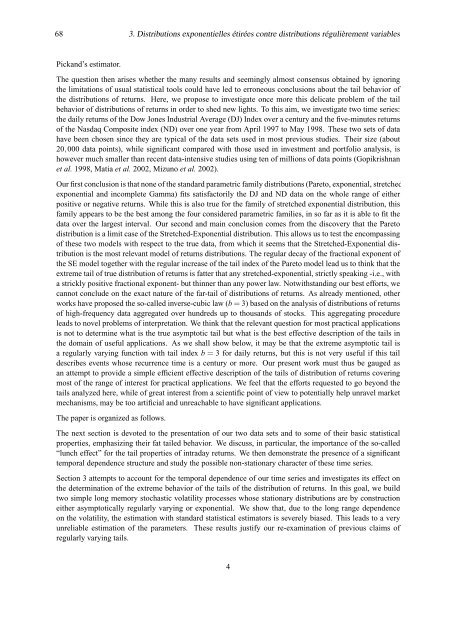statistique, théorie et gestion de portefeuille - Docs at ISFA
statistique, théorie et gestion de portefeuille - Docs at ISFA
statistique, théorie et gestion de portefeuille - Docs at ISFA
You also want an ePaper? Increase the reach of your titles
YUMPU automatically turns print PDFs into web optimized ePapers that Google loves.
68 3. Distributions exponentielles étirées contre distributions régulièrement variables<br />
Pickand’s estim<strong>at</strong>or.<br />
The question then arises wh<strong>et</strong>her the many results and seemingly almost consensus obtained by ignoring<br />
the limit<strong>at</strong>ions of usual st<strong>at</strong>istical tools could have led to erroneous conclusions about the tail behavior of<br />
the distributions of r<strong>et</strong>urns. Here, we propose to investig<strong>at</strong>e once more this <strong>de</strong>lic<strong>at</strong>e problem of the tail<br />
behavior of distributions of r<strong>et</strong>urns in or<strong>de</strong>r to shed new lights. To this aim, we investig<strong>at</strong>e two time series:<br />
the daily r<strong>et</strong>urns of the Dow Jones Industrial Average (DJ) In<strong>de</strong>x over a century and the five-minutes r<strong>et</strong>urns<br />
of the Nasdaq Composite in<strong>de</strong>x (ND) over one year from April 1997 to May 1998. These two s<strong>et</strong>s of d<strong>at</strong>a<br />
have been chosen since they are typical of the d<strong>at</strong>a s<strong>et</strong>s used in most previous studies. Their size (about<br />
20,000 d<strong>at</strong>a points), while significant compared with those used in investment and portfolio analysis, is<br />
however much smaller than recent d<strong>at</strong>a-intensive studies using ten of millions of d<strong>at</strong>a points (Gopikrishnan<br />
<strong>et</strong> al. 1998, M<strong>at</strong>ia <strong>et</strong> al. 2002, Mizuno <strong>et</strong> al. 2002).<br />
Our first conclusion is th<strong>at</strong> none of the standard param<strong>et</strong>ric family distributions (Par<strong>et</strong>o, exponential, str<strong>et</strong>che<strong>de</strong>xponential<br />
and incompl<strong>et</strong>e Gamma) fits s<strong>at</strong>isfactorily the DJ and ND d<strong>at</strong>a on the whole range of either<br />
positive or neg<strong>at</strong>ive r<strong>et</strong>urns. While this is also true for the family of str<strong>et</strong>ched exponential distribution, this<br />
family appears to be the best among the four consi<strong>de</strong>red param<strong>et</strong>ric families, in so far as it is able to fit the<br />
d<strong>at</strong>a over the largest interval. Our second and main conclusion comes from the discovery th<strong>at</strong> the Par<strong>et</strong>o<br />
distribution is a limit case of the Str<strong>et</strong>ched-Exponential distribution. This allows us to test the encompassing<br />
of these two mo<strong>de</strong>ls with respect to the true d<strong>at</strong>a, from which it seems th<strong>at</strong> the Str<strong>et</strong>ched-Exponential distribution<br />
is the most relevant mo<strong>de</strong>l of r<strong>et</strong>urns distributions. The regular <strong>de</strong>cay of the fractional exponent of<br />
the SE mo<strong>de</strong>l tog<strong>et</strong>her with the regular increase of the tail in<strong>de</strong>x of the Par<strong>et</strong>o mo<strong>de</strong>l lead us to think th<strong>at</strong> the<br />
extreme tail of true distribution of r<strong>et</strong>urns is f<strong>at</strong>ter th<strong>at</strong> any str<strong>et</strong>ched-exponential, strictly speaking -i.e., with<br />
a strickly positive fractional exponent- but thinner than any power law. Notwithstanding our best efforts, we<br />
cannot conclu<strong>de</strong> on the exact n<strong>at</strong>ure of the far-tail of distributions of r<strong>et</strong>urns. As already mentioned, other<br />
works have proposed the so-called inverse-cubic law (b = 3) based on the analysis of distributions of r<strong>et</strong>urns<br />
of high-frequency d<strong>at</strong>a aggreg<strong>at</strong>ed over hundreds up to thousands of stocks. This aggreg<strong>at</strong>ing procedure<br />
leads to novel problems of interpr<strong>et</strong><strong>at</strong>ion. We think th<strong>at</strong> the relevant question for most practical applic<strong>at</strong>ions<br />
is not to d<strong>et</strong>ermine wh<strong>at</strong> is the true asymptotic tail but wh<strong>at</strong> is the best effective <strong>de</strong>scription of the tails in<br />
the domain of useful applic<strong>at</strong>ions. As we shall show below, it may be th<strong>at</strong> the extreme asymptotic tail is<br />
a regularly varying function with tail in<strong>de</strong>x b = 3 for daily r<strong>et</strong>urns, but this is not very useful if this tail<br />
<strong>de</strong>scribes events whose recurrence time is a century or more. Our present work must thus be gauged as<br />
an <strong>at</strong>tempt to provi<strong>de</strong> a simple efficient effective <strong>de</strong>scription of the tails of distribution of r<strong>et</strong>urns covering<br />
most of the range of interest for practical applic<strong>at</strong>ions. We feel th<strong>at</strong> the efforts requested to go beyond the<br />
tails analyzed here, while of gre<strong>at</strong> interest from a scientific point of view to potentially help unravel mark<strong>et</strong><br />
mechanisms, may be too artificial and unreachable to have significant applic<strong>at</strong>ions.<br />
The paper is organized as follows.<br />
The next section is <strong>de</strong>voted to the present<strong>at</strong>ion of our two d<strong>at</strong>a s<strong>et</strong>s and to some of their basic st<strong>at</strong>istical<br />
properties, emphasizing their f<strong>at</strong> tailed behavior. We discuss, in particular, the importance of the so-called<br />
“lunch effect” for the tail properties of intraday r<strong>et</strong>urns. We then <strong>de</strong>monstr<strong>at</strong>e the presence of a significant<br />
temporal <strong>de</strong>pen<strong>de</strong>nce structure and study the possible non-st<strong>at</strong>ionary character of these time series.<br />
Section 3 <strong>at</strong>tempts to account for the temporal <strong>de</strong>pen<strong>de</strong>nce of our time series and investig<strong>at</strong>es its effect on<br />
the d<strong>et</strong>ermin<strong>at</strong>ion of the extreme behavior of the tails of the distribution of r<strong>et</strong>urns. In this goal, we build<br />
two simple long memory stochastic vol<strong>at</strong>ility processes whose st<strong>at</strong>ionary distributions are by construction<br />
either asymptotically regularly varying or exponential. We show th<strong>at</strong>, due to the long range <strong>de</strong>pen<strong>de</strong>nce<br />
on the vol<strong>at</strong>ility, the estim<strong>at</strong>ion with standard st<strong>at</strong>istical estim<strong>at</strong>ors is severely biased. This leads to a very<br />
unreliable estim<strong>at</strong>ion of the param<strong>et</strong>ers. These results justify our re-examin<strong>at</strong>ion of previous claims of<br />
regularly varying tails.<br />
4




